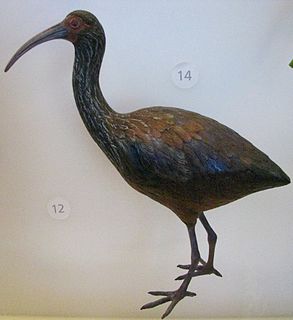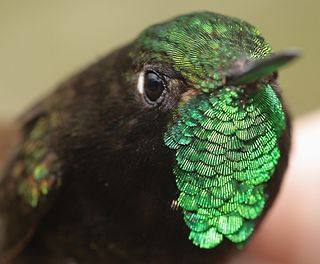 W
WThe Antillean cave rail, also known as DeBooy's rail, is an extinct rail species which occurred on Puerto Rico and the United States Virgin Islands. Bone fragments of this species were first unearthed by archaeologist Theodoor de Booy in kitchen midden deposits on the Richmond estate near Christiansted, U.S. Virgin Islands in July 1916 and described by Alexander Wetmore in 1918. The Antillean cave rail might have become extinct before the arrival of the Europeans but stories heard by Alexander Wetmore on Puerto Rico in 1912 about an easy-to-catch bird named carrao might refer to this species. The Antillean cave rail was apparently flightless and was hunted as food by the aborigines
 W
WThe Saint Helena rail was a large flightless rail from Saint Helena. It became extinct in the early 16th century.
 W
WApteribis is an extinct genus of flightless birds in the ibis subfamily that was endemic to the Hawaiian Islands in the Pacific Ocean.
 W
WBathornis is an extinct lineage of birds related to modern day seriemas, that lived in North America about 37–20 million years ago. Like the closely related and also extinct phorusrhacids, it was a flightless predator, occupying predatory niches in environments classically considered to be dominated by mammals. It was a highly diverse and successful genus, spanning a large number of species that occurred from the Priabonian Eocene to the Burdigalian Miocene epochs.
 W
WBathornis is an extinct lineage of birds related to modern day seriemas, that lived in North America about 37–20 million years ago. Like the closely related and also extinct phorusrhacids, it was a flightless predator, occupying predatory niches in environments classically considered to be dominated by mammals. It was a highly diverse and successful genus, spanning a large number of species that occurred from the Priabonian Eocene to the Burdigalian Miocene epochs.
 W
WThe leafbirds (Chloropseidae) are a family of small passerine bird species found in the Indian Subcontinent and Southeast Asia. They were formerly grouped with the ioras and fairy-bluebirds in the family Irenidae. As presently defined, the leafbird family is monogeneric, with all species placed in the genus Chloropsis.
 W
WThe Puerto Rican crow is an extinct crow species in the family Corvidae. It lived on Puerto Rico and the United States Virgin Islands. Little is known about its habitat, but it possibly died out after the colonization of humans on these islands.
 W
WThe St. Croix macaw or Puerto Rican macaw, is an extinct species of macaw whose remains have been found on the Caribbean islands of St. Croix and Puerto Rico. It was described in 1937 based on a tibiotarsus leg bone unearthed from a kitchen midden at a pre-Columbian site on St. Croix. A second specimen consisting of various bones from a similar site on Puerto Rico was described in 2008, while a coracoid from Montserrat may belong to this or another extinct species of macaw. The St. Croix macaw is one of 13 extinct macaw species that have been proposed to have lived on the Caribbean islands. Macaws were frequently transported long distances by humans in prehistoric and historical times, so it is impossible to know whether species known only from bones or accounts were native or imported.
 W
WMayrornis is a genus of bird in the family Monarchidae found in the Solomon Islands and Fiji. The name Mayrornis is a compound word. The first part, Mayr, commemorates Ernst Walter Mayr, a German ornithologist and systematist. The second part, ornis, is the Greek word meaning "bird". Established by Frank Alexander Wetmore in 1932, it contains the following species:
 W
WThe mesites (Mesitornithidae) are a family of birds that are part of a clade (Columbimorphae) that include Columbiformes and Pterocliformes. They are smallish flightless or near flightless birds endemic to Madagascar. They are the only family with more than two species in which every species is threatened.
 W
WThe mesites (Mesitornithidae) are a family of birds that are part of a clade (Columbimorphae) that include Columbiformes and Pterocliformes. They are smallish flightless or near flightless birds endemic to Madagascar. They are the only family with more than two species in which every species is threatened.
 W
WThe Perijá metaltail is a species of hummingbird in the family Trochilidae. It is endemic to páramo and elfin forest at high altitudes of the Perijá Mountains in Colombia and Venezuela. It is threatened by habitat loss.
 W
WBathornis is an extinct lineage of birds related to modern day seriemas, that lived in North America about 37–20 million years ago. Like the closely related and also extinct phorusrhacids, it was a flightless predator, occupying predatory niches in environments classically considered to be dominated by mammals. It was a highly diverse and successful genus, spanning a large number of species that occurred from the Priabonian Eocene to the Burdigalian Miocene epochs.
 W
WNesotrochis is a genus of extinct flightless rails in the family Rallidae. Its species are considered examples of insular gigantism. This genus, only known empirically from subfossil remains, contains the following species, which are collectively known as West Indian cave-rails:Antillean cave rail, Nesotrochis debooyi - may have survived until historic times Haitian cave-rail, Nesotrochis steganinos - prehistoric Cuban cave-rail, Nesotrochis picapicensis - prehistoric
 W
WThe Puerto Rican nightjar or Puerto Rican Whip-poor-will is a bird in the nightjar family found in the coastal dry scrub forests in localized areas of southwestern Puerto Rico. It was described in 1916 from bones found in a cave in north central Puerto Rico and a single skin specimen from 1888, and was considered extinct until observed in the wild in 1961. The current population is estimated as 1,400-2,000 mature birds. The species is currently classified as Endangered due to pressures from habitat loss.
 W
WThe Nihoa millerbird is a subspecies of the millerbird. It gets its name from its preferred food, the Miller moth. The 5-inch (13 cm) long millerbird has dark, sepia-colored feathers, white belly, and dark beak. Its natural geographic range is limited to the tiny island of Nihoa in the Northwestern Hawaiian Islands, and it is hoped that birds translocated to Laysan will help to ensure the survival of the species. The Nihoa millerbird is one of the two endemic birds remaining on Nihoa, the other being the Nihoa finch.
 W
WThe South American painted-snipe, or lesser painted-snipe, is a shorebird in the family Rostratulidae. There are two other species in its family, the Australian painted-snipe and the greater painted-snipe.
 W
WThe Puerto Rican barn owl is an extinct species of barn owl that inhabited the island of Puerto Rico in the Caribbean. It is sometimes considered to be a subspecies of the ashy-faced owl.
 W
WPresbyornis is an extinct genus of anseriform bird. It contains two unequivocally accepted species; the well-known P. pervetus and the much lesser-known P. isoni. P. pervetus was approximately the size and shape of a goose, but with longer legs; P. isoni, known from a few bones, was much larger, more than swan-sized. Other fossils, more doubtfully assigned to this genus, are also known.
 W
WPresbyornithidae is an extinct group of birds with a global distribution. They had evolved by the late Cretaceous period and became extinct during the early Miocene. Initially, they were believed to present a mix of characters shown by waterbirds, shorebirds and flamingos and were used to argue for an evolutionary relationship between these groups, but they are now generally accepted to be waterfowl closely related to modern ducks, geese, and screamers.
 W
WThe Puerto Rican quail-dove is an extinct species of dove from the genus of quail-doves Geotrygon. It is only known by subfossil material from the Holocene.
 W
WThe Tuxtla quail-dove or Veracruz quail-dove is a species of bird in the family Columbidae. It is endemic to pristine montane rainforest in the Sierra de los Tuxtlas of Mexico's Veracruz state. It was once considered a subspecies of the purplish-backed quail-dove of Central America.
 W
WThe Tacarcuna wood quail is a species of bird in the family Odontophoridae. It is found in Colombia and Panama. Its natural habitat is subtropical or tropical moist montane forests. It is threatened by habitat loss.
 W
WThe Raphinae are a clade of extinct flightless birds formerly called didines or didine birds. They inhabited the Mascarene Islands of Mauritius and Rodrigues, but became extinct through hunting by humans and predation by introduced non-native mammals following human colonisation in the 17th century. Historically, many different groups have been named for both the dodo and the Rodrigues solitaire, not all grouping them together. Most recently, it is considered that the two birds can be classified in Columbidae, often under the subfamily Raphinae. The first person to suggest a close affinity to the doves was Johannes Theodor Reinhardt, whose opinions were then supported by Hugh Edwin Strickland and Alexander Gordon Melville.
 W
WThe Saint Helena rail was a large flightless rail from Saint Helena. It became extinct in the early 16th century.
 W
WThe tapaculos are a family, Rhinocryptidae, of small suboscine passerine birds, found mainly in South America and with the highest diversity in the Andean regions. Three species are found in southern Central America.
 W
WThe sandy gallito is a species of bird in the family Rhinocryptidae. It is monotypic within the genus Teledromas. It is endemic to Argentina.
 W
WThe La Selle thrush is a species of bird in the family Turdidae native to Hispaniola. A skulker of broadleaf and pine forests around 1300m, it is limited to a small and declining population in inland Dominican Republic, as well as a relict population in Haiti.
 W
WTyto pollens was an extinct giant barn owl which lived in the Bahamas during the last Ice Age.
 W
WThe greater yellow-headed vulture, also known as the forest vulture, is a species of bird in the New World vulture family Cathartidae. It was considered to be the same species as the lesser yellow-headed vulture until they were split in 1964. It is found in South America in tropical moist lowland forests. It is a fairly large bird, with a wingspan of 166–178 cm (65–70 in), a weight of 1.65 kilograms (3.6 lb) and a body length of 64–75 cm (25–30 in). The body plumage is black, and the head and neck, which are featherless, range in color from deep yellow to pale orange. It lacks a syrinx, and its vocalizations are therefore limited to grunts or low hisses.